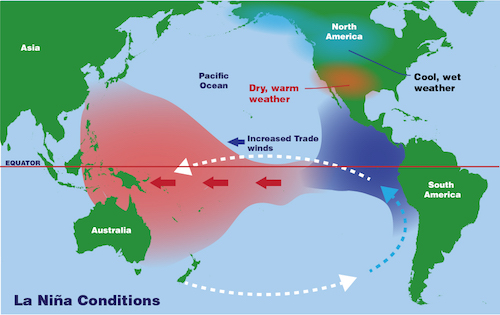We're moving into fall and looking ahead, the outlook for winter temperatures continues the trend toward warmer temperatures.
La Nina
One of the drivers could be a return of La Nina, which you hear about every few years. A La Nina event occurs when there is a strong easterly flow of surface ocean currents and surface winds north of the Equator in the Pacific Ocean. This pushes warm surface water towards Australia and Indonesia, as shown below.
This in turn changes where the polar jet stream is located, which directly affects our winter temperatures. In La Nina events the polar jet is typically farther north over the western United States. The jet may be closer to Illinois but usually doesn’t dip too far south, allowing more mild air to be present in Illinois.
Having said that, this event may be very weak, so it may not be the top driver of winter weather.
The Arctic Oscillation
Another driver of winter weather in Illinois is the Arctic Oscillation. This is a measure of air pressure differences between the Arctic and northern Pacific and Atlantic oceans. When the air pressure is lower than average over the Arctic and higher than average over the northern Pacific and Atlantic, the polar jet stream stays farther north. This is called a positive phase Oscillation. During a negative phase, when air pressure is higher than average in the Arctic and lower than average over the oceans, the jet stream.
In the graph below, see the big negative dip in early 2021? Remember those two extremely cold weeks in February? They match up very closely.
The Arctic Oscillation (AO) is a little harder to predict several months out, but sometimes this can quickly change, and if it goes strongly negative, we can still get a blast of cold Arctic air, although it may not last long.
The Madden/Julian Oscillation
Another atmospheric process that can affect our winters is the Madden/Julian Oscillation, MJO. No, it’s not John Madden.
According to Jon Gottschalck and Wayne Higgins of the Climate Prediction Center, the two most significant impacts of the MJO over the US winter are an increase in the frequency and intensity of heavy precipitation events along the US west coast and an increase in the frequency and intensity of cold air outbreaks across the eastern US.
The MJO is are waves of unsettled and fair weather that move around the earth in the tropics towards the east.
From the MET office (United Kingdom), there is evidence that the MJO influences the El Nino Southern Oscillation (ENSO) cycle. It does not cause El Nino or La Nina, but it can contribute to the speed of development and intensity of El Nino and La Nina episodes. The MJO appears to be more active during neutral and weak ENSO years. (Remember earlier the prediction is for a weak La Nina this winter?)
There is also evidence to suggest that the MJO can influence the onset of a Sudden Stratospheric Warming (SSW) event. Associate this with a polar vortex outbreak.
So what will winter bring?
We’ll have to wait and see, but at this point, our winter may be on average a mild one, with some short blasts of very cold air. Keep your mittens handy.
MEET THE AUTHOR
Duane Friend is an energy and environmental stewardship educator with University of Illinois Extension, serving the organization in many roles since 1993. Duane provides information and educational programs to adult and youth audiences in the areas of soil quality, weather and climate, energy conservation, and disaster preparedness. These programs provide practical solutions for families, farms, and communities. He assists families in creating a household emergency plan, farmers with the implementation of soil management and conservation practices, and local government officials and business owners with energy conservation techniques.
ABOUT THE BLOG
All About Weather is a blog that explores the environment, climate, and weather topics for Illinois. Get in-depth information about things your weather app doesn't cover from summer droughts to shifting weather patterns.





